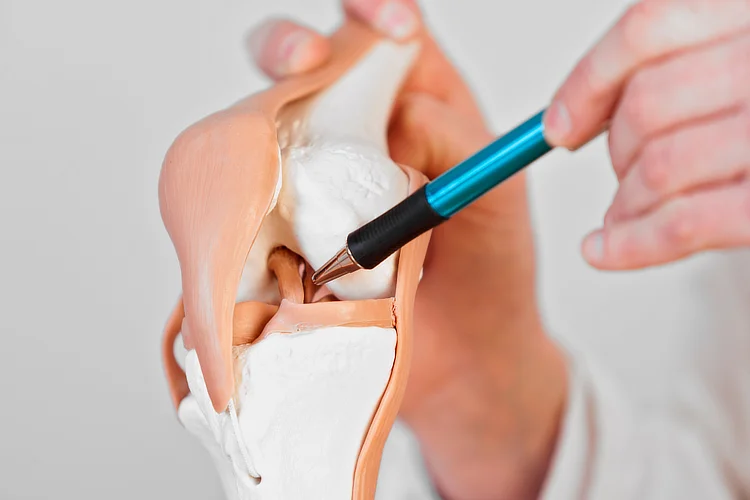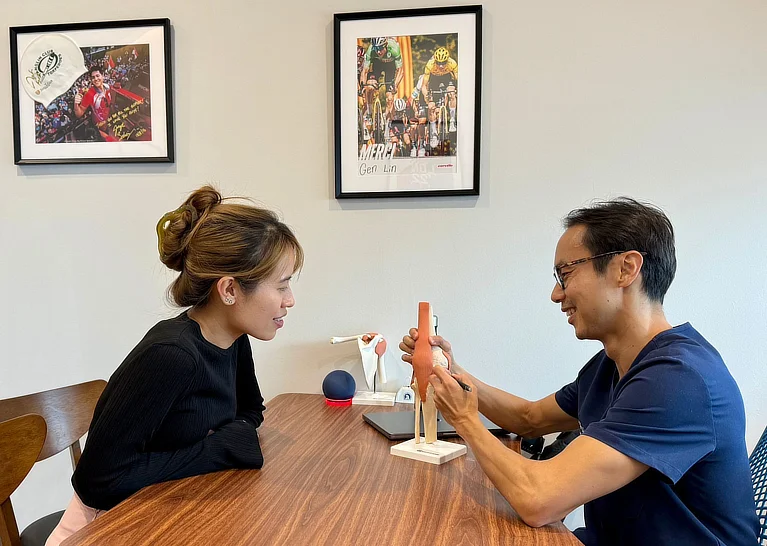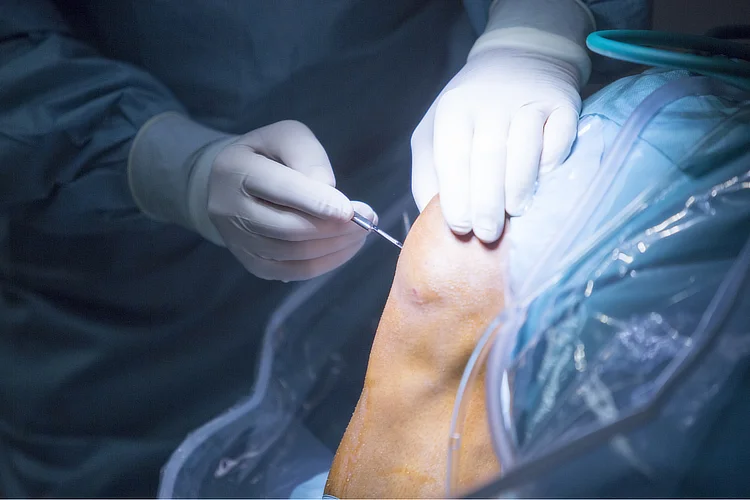ACL Reconstruction Surgery
ACL reconstruction surgery restores knee stability after a ligament tear. Dr Foo offers precise surgical care and personalised rehab to support safe return to movement and sport.
MBBS (University of London) | MMed (Ortho) | FRCSEd (Ortho) | FAMS (Ortho)



What Is ACL Reconstruction Surgery?
Anterior cruciate ligament (ACL) reconstruction is a surgical procedure that repairs
a torn ACL, one of the
key ligaments in the knee joint.
The ACL stabilises the knee by preventing excessive forward movement of the shin bone
(tibia) and controlling rotational motion. A torn ACL can lead to knee instability,
pain, and impaired mobility, particularly in active individuals and athletes.
When Is ACL Reconstruction Necessary?
ACL reconstruction is generally recommended for individuals who experience knee instability
following an ACL tear, especially those who engage in sports or physically demanding activities.
Surgery may also be advised if frequent knee buckling makes daily activities difficult.
The need for surgery depends on the severity of the tear, classified into three grades:
| Type of ACL Tear | Treatment |
|---|---|
| Grade 1 Sprain | The ligament is stretched but not torn. The knee remains stable, and symptoms can often be managed with physiotherapy and bracing. |
| Grade 2 Partial Tear | The ligament is partially torn, leading to some instability. While the torn fibres do not fully regenerate, physiotherapy can strengthen the surrounding muscles to compensate for the damage, and bracing can provide additional support. Non-surgical treatment may be effective for those with lower activity levels, but individuals who participate in high-impact activities may still require surgery. |
| Grade 3 Complete Tear | The ligament is fully ruptured and cannot heal on its own. Without treatment, your knee may remain unstable, increasing the risk of further cartilage and meniscus damage. Surgery is typically required to restore stability. |
Delaying treatment for an ACL tear can lead to chronic instability and increase the risk of further knee damage, potentially requiring more extensive intervention.

How Is ACL Reconstruction Surgery Performed?
Diagnosing an ACL tear typically involves physical assessments and imaging techniques by a doctor or knee specialist to evaluate the injury. Common methods include:
1. Pre-Surgical Evaluation
Before surgery, a thorough assessment includes a physical examination, medical history review, and imaging tests such as MRI scans to determine the extent of the injury. Your surgeon will also evaluate whether additional damage to the meniscus or cartilage requires treatment.
2. Graft Selection
ACL reconstruction involves replacing the torn ligament with a graft, which is a piece of tissue used to restore function and stability to the knee. The three common graft options are:
- Autograft: Uses the patient’s own tissue, typically from the patellar tendon, hamstring tendon, or quadriceps tendon, as these provide strong, reliable support for knee function.
- Allograft: Uses donor tissue, often from a cadaver, which avoids the need for a second surgical site but may have a longer healing time.
- Synthetic Graft: An artificial ligament, though less commonly used due to durability concerns.
Your surgeon will discuss with you and recommend options based on your activity levels and recovery goals.

3. Surgical Procedure
ACL reconstruction is performed using arthroscopy, a minimally invasive technique that reduces scarring and speeds up recovery. The key steps include:
- Incisions: Small incisions are made around the knee, and an arthroscope (a thin camera) is inserted to provide a clear view of the joint.
- Diagnostic Examination: The knee structures are examined, including ligaments, cartilage, and meniscus, to assess the extent of damage and address any additional injuries.
- Repair or Reconstruction: Specialised surgical instruments are inserted through additional small incisions to remove remnants of the damaged ACL.
- Graft Placement & Fixation: Bone tunnels are drilled into the femur and tibia, where the selected graft is placed to act as the new ACL. The graft is secured using screws, sutures, or fixation devices to ensure stability as it integrates with the surrounding bone and soft tissue.
- Closure: The arthroscope and instruments are removed, and the incisions are closed with sutures or surgical tape. A bandage is applied to protect the site, and post-operative care begins immediately.
Most individuals are discharged on the same day and prescribed a few days of rest, along with a knee brace, crutches, and medication to manage pain.
Recovery Time After ACL Reconstruction Surgery
Recovery from ACL reconstruction typically takes 6 to 12 months, depending on individual health and adherence to physiotherapy. The focus is on restoring knee function, strength, and stability while ensuring proper graft healing.
| Recovery Stage | Function & Mobility |
|---|---|
| 0-6 Weeks: Immediate Phase |
Pain and swelling gradually decrease. Mobility is limited, with crutches and a brace for support. Early range-of-motion exercises help prevent stiffness, but full weight-bearing is restricted. |
| 6-12 Weeks: Strengthening Phase |
Knee stability improves, and weight-bearing increases. Mobility improves, allowing controlled walking without assistive devices. Physiotherapy may incorporate strength exercises for quadriceps and hamstrings. |
| 3-6 Months: Advanced Rehabilitation |
Strength and endurance build with more demanding exercises. Balance and agility training may be introduced to enhance knee control. Light jogging and low-impact activities may begin under supervision. |
| 6-12 Months: Full Return |
Full knee function is restored, with strength nearing pre-injury levels. Sport-specific training prepares the knee for dynamic movements. High-impact activities and competitive sports can resume with medical clearance. |
Risks of ACL Reconstruction Surgery
While ACL reconstruction is a commonly performed procedure, it carries potential risks and considerations, as with all surgeries. These may include:
- Infection: Though uncommon, infections can occur at the surgical site and may require antibiotics or further intervention.
- Blood Clots: Limited mobility after surgery increases the risk of deep vein thrombosis (DVT), which may require blood-thinning medication or compression therapy.
- Knee Stiffness or Reduced Range of Motion: Some individuals may experience difficulty regaining full flexibility in the long-term, especially if post-operative physiotherapy is not followed consistently.
- Graft Failure or Re-injury: The new ligament can weaken or tear, particularly if rehabilitation is not properly managed or if a return to sports occurs too soon.
- Persistent Knee Pain: While temporary pain is common post-surgery, chronic discomfort in the inner or anterior knee may develop due to scar tissue, changes in knee mechanics, or underlying joint issues.
Your surgeon will discuss these and other potential risks with you before surgery to ensure you are fully informed.
ACL Reconstruction Cost
The cost of ACL reconstruction surgery varies, with estimated costs as follows:
| Procedure | Estimated Cost (SGD) |
|---|---|
| ACL Reconstruction Surgery | $20,000 – $30,000 |
The cost typically includes the procedure and standard post-operative care, but additional
expenses may arise from pre-surgical assessments, follow-ups, and rehabilitation.
In Singapore, ACL surgery is MediSave-claimable, with the claimable
amount depending on the procedure's complexity. Integrated Shield Plans may offer additional
coverage. Contact us to explore your financial options and coverage based on your needs.
Every patient deserves a treatment plan tailored to their needs. We start with non-surgical approaches before considering more invasive interventions.
Where Can I Find an ACL Surgeon in Singapore?
Apex Novena
admin@apexsportsclinic.sg
101 Irrawaddy Rd, #18-12 Royal Square Medical Centre, Singapore 329565
Nearest MRT: NS20 Novena
Apex East Coast
admin@apexsportsclinic.sg
112 E Coast Rd, #03-03/04 i12 Katong, Singapore 428802
Nearest MRT: TE26 Marine Parade
Why Do Patients Choose Apex Sports Clinic?
Sports Doctor in Singapore: Personalised & Affordable Care
Progressive Treatment Philosophy
We prioritise personalised, non-invasive solutions, progressing to specialised treatments, including surgery, only when needed for more effective and targeted care.
Holistic Patient-Centred Care
From diagnosis to rehabilitation, we provide comprehensive and seamless care for a wide range of orthopaedic conditions.
Specialist in Sports Orthopaedics & Injury Management
We combine expert injury management with a proactive approach to maintaining your body’s strength and function, so you can recover fully and perform at your peak.
Patient Journey
1 . Schedule Your Appointment

2 . Expert Diagnosis & Consultation

3 . Customised Treatment Plan

Schedule an Appointment

Our Insurance Partners






Frequently Asked Questions (FAQs)
ACL reconstruction is typically considered a moderate surgical procedure. While it is more complex than minor surgeries, it is less invasive compared to major procedures like knee replacements. Modern techniques use minimally invasive arthroscopy, which helps reduce recovery time and potential complications.
Recovery typically takes 6 to 12 months, depending on individual healing and adherence to rehabilitation. The process is gradual, starting with pain and swelling management, followed by progressive strength training, mobility exercises, and sport-specific training before returning to high-impact activities.
Living with a torn ACL depends on the severity of the tear and your activity level. A partial tear may be manageable with physiotherapy and bracing, but a complete tear often leads to knee instability, increasing the risk of further cartilage or meniscus damage. If you engage in sports or physically demanding activities, surgery may be necessary to restore stability.
Yes, but it is generally recommended to keep the leg elevated and in a straight position, especially in the initial weeks, to reduce swelling and support healing. Some individuals find it more comfortable to use pillows for support. Your physiotherapist will guide you on the best sleeping position to aid recovery.
Many individuals regain full knee function and return to sports or daily activities after ACL surgery. However, recovery outcomes vary depending on rehabilitation adherence, graft healing, and muscle strength. Some may experience occasional stiffness or discomfort, but with proper physiotherapy and strength training, knee function can be close to pre-injury levels.
Walking with crutches is typically possible within the first few days after surgery. However, full weight-bearing without support depends on individual progress and physiotherapy guidance. Most individuals begin walking more confidently without crutches between four to six weeks post-surgery as knee strength and stability improve.
Yes, but movement is initially restricted to protect the healing graft. Physiotherapy includes gentle bending exercises to gradually restore flexibility. By 6 to 12 weeks, most individuals can bend their knee more naturally as strength and mobility improve.
Climbing stairs is possible within the first few weeks, but it should be done cautiously with support. Initially, individuals are advised to use crutches and take one step at a time. Strength and stability gradually improve over the following weeks, allowing for easier stair navigation.
Complications after ACL reconstruction may present as excessive swelling, redness, or persistent pain that does not improve with rest or medication. Difficulty bearing weight or sudden knee instability should be addressed promptly. Signs of infection, such as warmth, pus, or fever, require prompt medical attention. Unusual clicking or locking that limits movement may also indicate a problem.
A completely torn ACL does not heal on its own and often leads to chronic knee instability. Over time, this instability may increase the risk of cartilage wear, meniscus tears, and early-onset osteoarthritis. If the knee remains unstable, surgery is typically recommended, particularly for active individuals or those whose daily activities are affected by the injury.
The graft used in ACL reconstruction is designed to be durable, but it is still susceptible to wear and potential re-injury, especially if exposed to high-impact activities too soon. With proper rehabilitation and knee care, the graft can function well for many years. However, some individuals may require revision surgery later in life due to wear or additional injuries.
Complete bed rest is not required, but a few days of reduced activity is typically recommended to manage pain and swelling. Light movement helps prevent stiffness and blood clots. Walking with crutches usually begins within the first week, depending on recovery progress. It is important to follow your surgeon’s instructions, as the wound remains fresh and vulnerable during the initial recovery phase.
Inner knee pain can occur, especially if a hamstring tendon autograft is used, as the graft is taken from the inner thigh. Surgical changes, scar tissue, or inflammation may also contribute to discomfort. Proper physiotherapy and rehabilitation usually help reduce pain over time. If pain persists, consult your surgeon for further evaluation.
The most difficult parts of ACL recovery are managing pain and swelling in the early weeks, restoring full movement without stiffness, and rebuilding strength and balance to prevent reinjury. Regaining confidence in knee stability, especially when returning to sports, can also be challenging. A structured rehabilitation plan and commitment to physiotherapy are essential for a smooth recovery.
Most individuals do not feel the screws used to secure the graft. However, in some cases, discomfort may arise if the hardware causes irritation. If this occurs, your surgeon may recommend further assessment, and in rare cases, screw removal may be considered if symptoms persist.
There is no strict age limit for ACL surgery. The decision depends on factors such as overall health, activity level, and personal goals. A doctor or specialist can evaluate your condition and recommend the most appropriate course of action based on your individual needs.
Pain varies between individuals, but it is generally manageable with prescribed medications and proper post-operative care. The initial few days tend to be the most uncomfortable, with gradual improvement over the following weeks.

